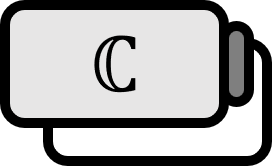Inversion in Complex Analysis
Definition 1
Consider a line $L: 2px + 2qy + c = 0$ and a circle $\mathscr{C}: |z - A | = r$, and a point $P: z = x + iy$ that is not on them. The inverse point is defined as follows.
- A $Q: z^{ \ast } = x^{ \ast } + i y^{ \ast }$ that satisfies $\displaystyle {{y - y^{ \ast }} \over {x - x^{ \ast }}} = {{q} \over {p}}$ and $p(x + x^{ \ast }) + q(y + i y^{ \ast }) + c = 0$ is defined as the inverse point of $P$ with respect to line $L$.
 2. A $Q: z^{ \ast } = x^{ \ast } + i y^{ \ast }$ that satisfies $\overline{AP} \cdot \overline{AQ} = r^2$ is defined as the inverse point of $P$ with respect to circle $\mathscr{C}$.
2. A $Q: z^{ \ast } = x^{ \ast } + i y^{ \ast }$ that satisfies $\overline{AP} \cdot \overline{AQ} = r^2$ is defined as the inverse point of $P$ with respect to circle $\mathscr{C}$.

Explanation
Defining the inverse point as a reflection point with respect to a line is quite intuitive, but the inverse point with respect to a circle may feel unfamiliar. Especially, the inverse point of the center of a circle being infinity, i.e., $P \to A$ when $Q \to \infty$, can be quite challenging to accept. However, it seems complicated only because of the definitions and illustrations; fundamentally, it is equivalent to taking $\displaystyle {{r^2} \over {z}}$ with the center of the circle and its axis.
If you are still not getting it, let’s say $\mathscr{C}: |z| = 2$ and directly calculate $Q$ by setting $P = 1$. By using trigonometry, it can be easily confirmed that $\displaystyle Q = 4 = { {2^2} \over {1} }$. It’s obvious that every point inside a circle corresponds one-to-one with every point outside the circle—such an easy concept wouldn’t have been overlooked. But trying to eliminate ambiguous expressions in writing led to many omissions, making it seem unfamiliar.
The following principles can be easily derived from the fact that circles and lines remain circles and lines even when subjected to bilinear transformations.
Symmetry Principle
Let’s say $z$ and $z^{ \ast }$ are inverse points to each other.
- [1] Line: $Bz + \overline{Bz} + c = 0$ $\iff$ $Bz^{ \ast } + \overline{Bz} + c = 0$
- [2] Circle: $a z \overline{z} + Bz + \overline{Bz} + c = 0$ $\iff$ $a z^{ \ast } \overline{z} + Bz^{ \ast } + \overline{Bz} + c = 0$
- [3] All bilinear transformations map the inverse point of $\tilde { \mathbb{C} }$ to the inverse point of $\tilde { \mathbb{C} }$.
Osborne (1999). Complex variables and their applications: p205. ↩︎
